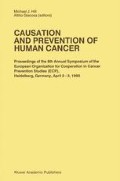Abstract
Malignant melanoma is one of the few cancers still increasing in incidence and mortality. The National Cancer Institute figures show that its mortality rate increases by 1.8% per year; for the decade 1975–1984, mortality increased by 23% in males and 10% in females. In the year 1983, melanoma was the second cause of death from cancer in people younger than 35 years.
Access this chapter
Tax calculation will be finalised at checkout
Purchases are for personal use only
Preview
Unable to display preview. Download preview PDF.
References
Jones, R.R. (1987), Ozone depletion and cancer risk. The Lancet, Aug. 22, 443–446.
Norman, C. (1981). Satellite data indicate ozone depletion. Science, 213, 1088–1089.
Redman, J.C. (1987). Stratospheric ozone depletion. A proposed solution to the problem. Am J Dermopathol, 9, 457–458.
Cesarini, J.P., Robert, P. (1985). Rayons ultraviolets. In: “Dermopharmacologie clinique” (ed. Robert, P.) pp. 223–231, Paris, Maloine.
Pathak, M.A., Harber, L.C., Seiji, M. et al. (1974). “Sunlight and man” (eds. Pathak, M.A. et al), Tokyo, University of Tokyo Press.
Bruls, W.A.G., Slaper, H. , Van der Leun, J.C, et al. (1984). Transmission of human epidermis and stratum corneum as a function of thickness in the ultraviolet and visible wavelength. Photochem Photobiol, 40, 485–494.
Cesarini, J.P. (1986). Le soleil et l’homme: physique et physiologie. Tribune médicale, 189, 13–18.
Spikes, J.D. (1983). Photosensitized reactions in mammals. In: “Experimental and clinical photoimmunology”,Vol. 1, (eds. Daynes, R.A. and Spikes, J.D.) pp. 69–80, Boca Raton, CRC Press.
Willis, I. (1983). Ultraviolet light and skin cancer. In: “Experimental and clinical photoimmunology”, Vol. II (eds. Daynes, R.A. and Krueger, G.) pp. 131–144, Boca Raton, CRC Press.
Stern, R.S. (1989). PUVA and the induction of skin cancer. Carcinog Compr Surv, 11, 85–101.
Baker-Blocker, A. (1980). Ultraviolet radiation and melanoma mortality in the United States. Environm Res, 23, 24–28.
Beitner, H., Ringborg, U., Wennersten, G. et al (1981). Further evidence for increased light sensitivity in patients with malignant melanoma. Br J Dermatol, 104, 289–294.
English, D.R., Heenan, P.J., D’Arcy, J. et al (1987). Melanoma in Western Australia in 1980–1981: incidence and characteristics of histological types. Pathology, 19, 383–392.
Kligman, A.M., Kaidbey, K.H. (1982). Human models for identification of photosensitizing chemicals. JNCI, 69, 269.
Young, L.F. (1981). Melanomas and sunlight. Med J Aust, 2, 258.
Lejeune, F.J., Joarlette, M. (1989). Soleil et cancer. Encyclopédie Médico-chirurgicale, 50035 A14–9, 1–10.
Silverstone, H., Searle, J.H.A. (1970). The epidemiology of skin cancer in Queensland. Br J Cancer, 24, 235–253.
Andre, J., Joarlette, M., Villar, J., Liénard, D., Verhest, A. et al (1989). Descriptive epidemiology of 415 cases of malignant melanomas observed in Brussels, Belgium in the eighties. Second International Conference on Melanoma, Venice, Italy, Fondazione Giorgio Cini, October 16–19, 1989.
Urbach, F., Epstein, J.H., Forbes, P.D. (1974). Ultraviolet carcinogenesis: experimental, global, and genetic aspects. In:”Sunlight and man”, (eds. Pathak, M.A. et al) pp.259–283, Tokyo, University of Tokyo Press.
Forbes, P.D. (1981). Photocarcinogenesis: an overview. J Invest Dermatol, 77, 139–143.
Van der Leun, J.C. (1984). UV-carcinogenesis. Photochem Photobiol, 39, 861–868.
Amblard, P., Beani , J.C, Reymond, J.L., Didier-Roberto, B. (1987). Photocarcinogenesis. Ann Dermatol Venereol, 114, 381–394.
Bergstresser, P.R., Streilein, J.W. (1983). Local effects of ultraviolet radiation on Langerhans cells and contact hypersensitivity. In: “Experimental and clinical photoimmuno1ogy”, Vol. II (eds. Daynes, R.A. and Krueger, G.) pp. 37–49, Boca Raton, CRC Press.
Lynch, D.H., Gurish, M.F., Daynes, R.A. (1983). Modification of lymphocyte and macrophage functions in vitro following UVL exposure. In: “Experimental and clinical photoimmuno1ogy”, Vol. II (eds. Daynes, R.A. and Krueger, G.) pp. 71–88, Boca Raton, CRC Press.
Green, M.I., Sy, M.S., Kripke, M. et al (1979). Impairment of antigen-presenting cell function by ultraviolet radiation. PNAS, 73, 6591.
Kraemer, K.H., Levis, W.R., Cason, J.C. et al (1981). Inhibition of mixed leukocyte culture reaction by 8-methoxypsoralen and long-wave-length ultraviolet radiation. J Invest Dermatol, 77, 235.
Lindhal-Kiessling, K., Safwenberg, J. (1971). Inability of UV-irradiated lymphocytes to stimulate allogeneic cells in mixed lymphocyte culture. Int Arch Allergy, 41, 670.
Moscicki, R., Morison, W., Bloch, K.J. et al (1981). Distribution of T cell subsets, identified by monoclonal antibodies in psoriasis treated with psoralen/ultraviolet-A radiation (PUVA). Clin Res, 29, 373A.
Sprangrude, G.J., Daynes, R.A. (1983). Oxygenated sterols as immunosuppressive agents. In: “Experimental and clinical photoimmunology”, Vol. II (eds. Daynes, R.A. and Krueger, G.) pp. 89–102, Boca Raton, CRC Press.
Holman, C.J., Armstrong, B.K., Heenan, P.J. (1983). A theory of the etiology and pathogenesis of human cutaneous malignant melanoma. JNCI, 71, 651.
Osterlind, A., Tucker, M.A., Hou-Jensen, K., Stone, B.J., Engholm, G., Jensen, O.M. (1988). The Danish case-control study of cutaneous malignant melanoma. I. Importance of host factors. Int J Cancer, 42, 200.
Swerdlow, A.J., English, J., MacKie, R., O’Doherty, C.J., Hunter, J.A.A., Clark, J., Hole, D.J. (1986).Benign melanocytic naevi as a risk factor for malignant melanoma. Brit Med J, 292, 1555–1559.
Parrish, J.A., White, H.A.D., Pathak, M.A. (1979). Photomedicine. In: “Dermatology in general medicine. Textbook and atlas” (eds. Fitzpatrick, T.B. et al) pp. 942–994, New York, McGraw-Hill Book Company.
ürbach, F. (1981). Skin cancer in man. a) Geographical and racial variations. In: “Biology of skin cancer (excluding melanoma)” A series of Workshops on the Biology of Human Cancer, report n.15. UICC Technical Report Series, Vol. 63 (eds. Laerum, O.D. et al) pp. 58–66 and 80–86, Geneva, UICC.
Author information
Authors and Affiliations
Editor information
Editors and Affiliations
Rights and permissions
Copyright information
© 1991 Springer Science+Business Media Dordrecht
About this chapter
Cite this chapter
Lejeune, F.J. et al. (1991). Malignant Melanoma: An Epidemiological Phenomenon. In: Hill, M.J., Giacosa, A. (eds) Causation and Prevention of Human Cancer. Developments in Oncology, vol 63. Springer, Dordrecht. https://doi.org/10.1007/978-94-011-3308-1_10
Download citation
DOI: https://doi.org/10.1007/978-94-011-3308-1_10
Publisher Name: Springer, Dordrecht
Print ISBN: 978-94-010-5460-7
Online ISBN: 978-94-011-3308-1
eBook Packages: Springer Book Archive

